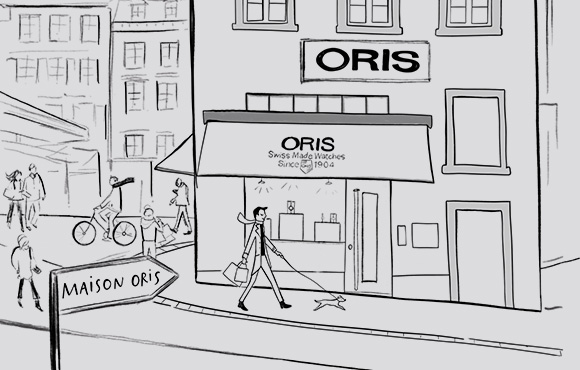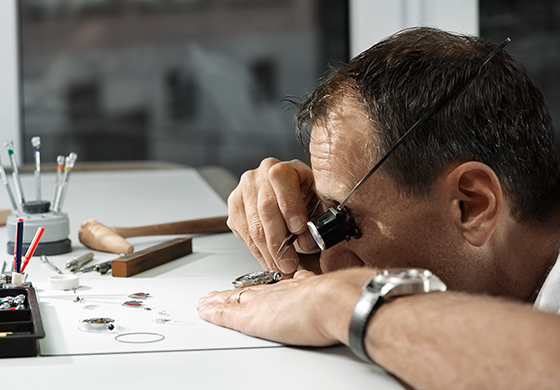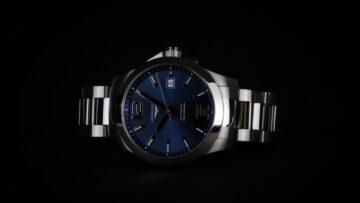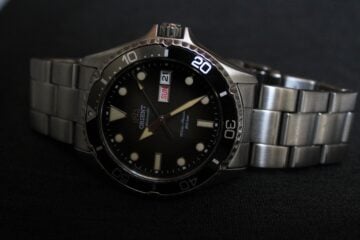Oris The Human Touch
Behind Oris’s industrial approach to watchmaking lies the hand of the traditional watchmaker
Until you’ve visited a modern Swiss watch factory, it’s hard to appreciate how advanced they’ve become. State-of-the-art machines that make parts to within microscopic tolerances; temperature-controlled laboratories with special systems that reduce air pollution; small armies of white-coat wearing technicians who go silently about their work everyday – some of them look more like Bond lairs than factories. Watchmaking has become a highly efficient, industrialised process. Long gone are the days when every step was completed by hand – today. only a few specialised companies follow those traditions to the letter. But while CAD drawings, high-tech CNC milling machines and ingenious automated assembly systems greatly reduce the levels of human involvement in watchmaking, for Oris, the intellect of the skilled watchmaker and the delicate hand of the craftsman are still an integral, irreplaceable part of the process. Oris continues to employ experts watchmakers, with a range of skill and responsibilities. Some of our watchmakers have been with the company for nearly half a century.
Werner Weiss joined Oris as an apprentice at 16 and has worked for the company for 47 years. He was the mastermind behind the Oris moonphase complication, which was the company’s flagship movement for 25 years before the arrival of Calibre 110 in 2014. Oris watchmakers also work in assembly, quality control and after sales – there are plenty of things machines still can’t do. ‘We may outsource the manufacturing of parts,’ says Oris chairman Ulrich W. Herzog, ‘but even during the 1970s and 1980s, when times were at their toughest, we never lost sight of the importance of the Swiss watchmaking tradition, nor of the value a highly trained watchmakers has in perpetuating that tradition. These are fundamental to us, which is why every Oris watch is a combination of the finest industrial manufacturing techniques and the timeless craft of a watchmaker.’
 Even in a watch with a so -called industrial finish, the hand of the craftsman is clear. Bridges with bevelled edges, polished cases and applied indices all require the human touch. The escapement, the dancing heart of every Oris watch, is so delicate and so sensitive that only a skilled watchmakers can assemble and regulate it. It’s these traditions that give a mechanical watch is soul. A watch produced entirely by machines will always feel disposable. A watch that’s been assembled and finished by hand feels like it will last forever. Which an Oris watch will – provided it is well maintained Every Oris watch comes with a 2 year guarantee, or three if you sign up to MyOris. Today’s watches are made using high-quality materials like stainless steel and sapphire crystal, using high-tech machinery and the latest manufacturing techniques.
Even in a watch with a so -called industrial finish, the hand of the craftsman is clear. Bridges with bevelled edges, polished cases and applied indices all require the human touch. The escapement, the dancing heart of every Oris watch, is so delicate and so sensitive that only a skilled watchmakers can assemble and regulate it. It’s these traditions that give a mechanical watch is soul. A watch produced entirely by machines will always feel disposable. A watch that’s been assembled and finished by hand feels like it will last forever. Which an Oris watch will – provided it is well maintained Every Oris watch comes with a 2 year guarantee, or three if you sign up to MyOris. Today’s watches are made using high-quality materials like stainless steel and sapphire crystal, using high-tech machinery and the latest manufacturing techniques.
But a mechanical watch is a living, breathing object, and subject to wear and tear, like any other object with moving parts. A quick look at the statistics helps explain this. The balance wheel in most mechanical watch movements oscillates around 28,000 times an hour (creating a watch’s ticking sound), or approximately 250 million times a year. That places huge pressure on the ent’s moving parts, which have to be checked, cleaned and lubricated at regular intervals., This is why we recommend a service on a new Oris watch every three to five years.
Oris’s respect for watchmaking isn’t confined to the inside of a watch. Through the centuries, watchmakers developed decorations and finishing techniques that allowed them to showcase their skills and stir the imagination. One such finish is guillochage, which create beautiful patterns on a dial. The new Artelier Chronometer, Date has an Art Deco-inspired guilloche dial, a signal that what lies beneath has been give real care and attention. In this case, that care has been applied to the movement’s accuracy – its chronometer status means it been independently certified for accuracy by the Official Swiss Chronometer Testing Institute, or COSC as its known. A watch that passes its stringent tests is accurate to -4/+6 seconds a fat – deserving of a special dial treatment.
 But there is no more visual way to demonstrate the watchmaker’s craft than through skeletonisation, the process of opening up a watch dial so the glorious intricacies of a watch’s movement are visible dial-side up, and in full view of the wearer at all times.’When a movement is hidden under a dial, you don’t get to see how it’s made, how complex it is, how much skill is required to keep that second hand ticking around the dia;,’ says Weiss. ‘Take the dial away and open up the movement, stripping back bridges, and you quickly see what goes into making a mechanical watch. There’s beauty in thwat, which is why collectors go crazzy for skeletonised watches.’
But there is no more visual way to demonstrate the watchmaker’s craft than through skeletonisation, the process of opening up a watch dial so the glorious intricacies of a watch’s movement are visible dial-side up, and in full view of the wearer at all times.’When a movement is hidden under a dial, you don’t get to see how it’s made, how complex it is, how much skill is required to keep that second hand ticking around the dia;,’ says Weiss. ‘Take the dial away and open up the movement, stripping back bridges, and you quickly see what goes into making a mechanical watch. There’s beauty in thwat, which is why collectors go crazzy for skeletonised watches.’
Oris has made skeletonised watches for decades. The current Artelier Skeleton and Artix Skeleton showcase the company’s passion for traditional watchmaking better than almost any other watch in the collection. ‘Who wouldn’t want to see inside a mechanical watch.’ says Herzog. ‘It’s like looking into your soul – few objects made today have such emotional power.’ As Oris takes back watchmaking, it will continue to focus on craftsmanship. Mechanical watches wouldn’t be the same without it.
Oris the human touch- what are your thoughts?






